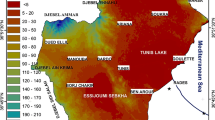Abstract
To secure operation of wastewater collection systems and treatment plants, it is so necessary to detect any probable vulnerability and estimate undesirable events and severity of their effects. In this paper, a model has been developed to evaluate system operation management in order to deal with serious conditions. The risk assessment phase contains three parts including evaluation of probability of threats, severity of their effects–consequences and vulnerability of the system components. These parameters could be measured by fuzzy multi-attribute decision-making techniques by questionnaire and through defining some criteria for threat assessment. In the risk management phase, risk-controlling approaches are developed by professionals based on risk assessment results and prioritizing the threats. Risk assessment and management model has been conducted through two case studies in Tehran, respectively, as a sample of wastewater collecting and the biggest wastewater treatment system in Iran. The results show that “entry of chemical contaminant” and “change in wastewater quality” were taken the highest score for the west Tehran wastewater collection network and “earthquake” in processing units, sludge treatment and gas storages were taken the highest score in the south Tehran wastewater treatment, reduction strategies of which were presented for dealing of each risk.






Similar content being viewed by others
References
Baah K, Dubey B, Harvey R, McBean E (2015) A risk-based approach to sanitary sewer pipe asset management. Sci Total Environ 505:1011–1017
Babovic V, Drecour JP, Keijzer M, Hansen PF (2002) Modeling of water supply assets: a data mining approach. Urban Water 4(4):404–414
Bagheri A, Darijani M, Asgary A, Morid S (2010) Crisis in Urban water systems during the reconstruction period: a system dynamics analysis of alternative policies after the 2003 earthquake in Bam-Iran. Water Resour Manag 24(11):2567–2596
Bonissone P (1982) A fuzzy sets based linguistic approach. In: Gupta MM, Sanchez E (eds) Approximate reasoning in decision analysis. North-Holland, Amsterdam, pp 329–339
Buckley JJ (1985) Fuzzy Hierarchical Analysis. Fuzzy Set Syst 17(3):223–247
Cieslak BT (2011) Fuzzy failure risk analysis in drinking water technical system. RT A 1(20):138–148
Delpla I, Monteith DT, Freeman C, Haftka J, Hermens J, Jones TG, Baurès E, Jung V, Thomas O (2014) A decision support system for drinking water production integrating health risks assessment. Int J Environ Res Public Health 11:7354–7375
Demotier S, Schon W, Denoeux T, Odeh K (2003) A new approach to assess risk in water treatment using the belief function framework. In: IEEE international conference on systems, man and cybernetics, vol 2. pp 1792–1797
Escer E, Perrodin Y, Keck G, Blonchard J, Vermande P (2010) Eco toxicological risk assessment of hospital wastewater a proposed framework for raw effluents discharging into urban sewer network. J Hazard Mater A 117(1):1–11
FEMA 452 (2005) A how to guide to mitigate potential terrorist attacks against buildings. Risk Manag Ser FEMA 452:3–6
Garvey P (2009) Analytical methods for risk management: a system engineering perspective. Taylor and Francis Group, Boca Rotan
Guikema S, Aven T (2010) Assessing risk from intelligent attacks: a perspective on approaches. Reliab Eng Syst Saf 95(5):478–483
Mays LW (2004) Urban water supply management tools. McGraw- Hill Engineering Reference, New York
Meritxell DC, Masscheleyn P, Peng C, Morrall SW (2010) Risk assessment approach for untreated wastewater using the QUAL2E water quality model. Chemosphere 52(4):55–66
Metcalf & Eddy Inc, Tchobanoglous G, Franklin L, Stensel HD (2003) Wastewater engineering: treatment and reuse, 4th edn. McGraw Hill Higher Education, New York, p 1771
Nazif S, Karamouz M (2009) Algorithm for assessment of water distribution system’s readiness: planning for disasters. J Water Resour Plann Manag 135:244–252
Rausand M, Høyland A (2004) System reliability theory. Models, statistical methods, and applications. Wiley, New Jersey
Roozbahani A, Zahraie B, Tabesh M (2013) Integrated risk assessment of urban water supply systems from source to tap. Stoch Environ Res Risk Assess 27(4):923–944
Saaty TL (1980) Decision making with the Analytic Hierarchy Process. Int J Serv Sci 1(1):83–98
Sadiq R, Tesfamariam S (2009) Environmental decision-making under uncertainty using intuitionistic fuzzy analytic hierarchy process (IF-AHP). Stoch Environ Res Risk Assess 23(1):75–91
Seto E, Konnan J, Olivieri A, Danielson R, Gray D (2016) A quantitative microbial risk assessment of wastewater treatment plant blending: case study in San Francisco Bay. Environ Sci Water Res Technol 2:134–145
Taheriyoun M, Moradinejad S (2015) Reliability analysis of a wastewater treatment plant using fault tree analysis and Monte Carlo simulation. Environ Monitor Assess 187:4186
Tehran Province Wastewater Company (2010) Main sewer line of west Tehran introduction report
Tehran Province Wastewater Company (2015) Engineering reports, www.ts.tpww.ir
Tidwell VC, Cooper JA, Silva CJ (2005) Threat assessment of water supply systems using markov latent effects modeling. J Water Resour Plan Manag 131(3):218–227
Torres JM, Brumbelow K, Guikema SD (2009) Risk classification and uncertainty propagation for virtual water distribution systems. J Reliab Eng Syst Saf 94:1259–1273
Van Leuven LJ (2011) Water/wastewater infrastructure security: a multilayered security approach. Seattle Public Utilities/U.S. Department of Homeland Security (DHS),FEMA, Washington
Warren L, Davis S, Cyr CT (2009) Emergency response planning for water and/or wastewater systems. Wiley Handbook of Science and Technology for Homeland Security, Hoboken
Website of Tehran Wastewater Company (2015) http://ts.tpww.ir/fa/p8/p18. Accessed 20 Apr 2016
Yager RR (1980) On a general class of fuzzy connectives. Fuzzy Set Syst 4:235–242
Acknowledgements
The authors are grateful for the efforts of all individuals, organizations and institutions, especially Mr. Ehteshami from Shahrak-e Gharb Wastewater Treatment Plant, Dr. Mohammadi from Tehran Province Water and Wastewater Department, Mr. Nour Mohammadi from south of Tehran wastewater treatment plant and Mr. Yadegari from FARAB Zist engineering company, for their cooperation to collect information and to fill the questionnaires.
Author information
Authors and Affiliations
Corresponding author
Rights and permissions
About this article
Cite this article
Asgarian, M., Tabesh, M., Roozbahani, A. et al. Risk Assessment and Management of Wastewater Collection and Treatment Systems Using FMADM Methods. Iran J Sci Technol Trans Civ Eng 42, 55–71 (2018). https://doi.org/10.1007/s40996-017-0062-3
Received:
Accepted:
Published:
Issue Date:
DOI: https://doi.org/10.1007/s40996-017-0062-3




